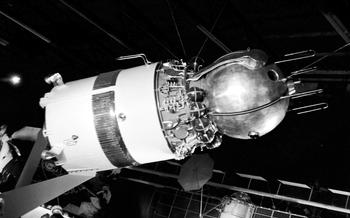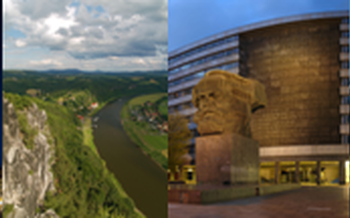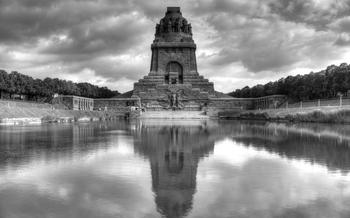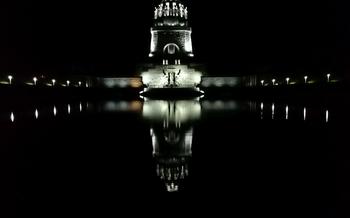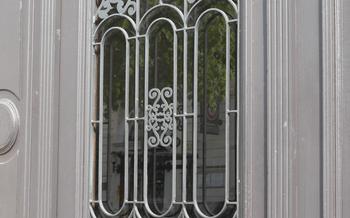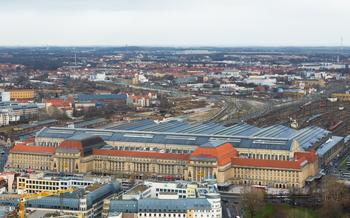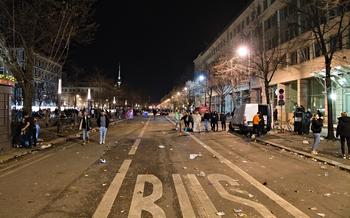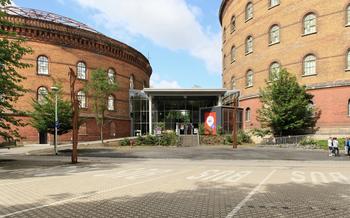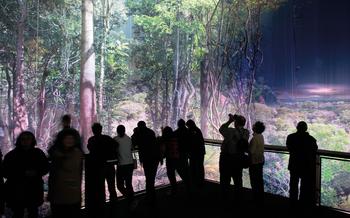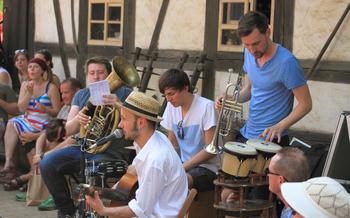
Leipzig Battle of the Nations Panorama
- Unveiling the History of the Battle of the Nations
- Exploring the Monumental Panorama Canvas
- Immerse Yourself in the 360-Degree Experience
- Discover the Battle of the Nations Museum (Völkerschlachtdenkmal)
- Unveiling the Secrets of the Monument's Architecture
- Wander through the Peaceful Parkland
- Paying Homage at the Mass Graves
- Unraveling the Stories of the Monument's Creators
- Tracing the Monument's Construction and Unveiling
- Engaging Educational Programs and Workshops
- Celebrate the Annual Commemoration Festival
- Capturing the Monument's Essence through Photography
- Insider Tip: Unveiling the Hidden Gem of the Monument
Unveiling the History of the Battle of the Nations
The Battle of the Nations in Leipzig, fought in October 1813, stands as a pivotal event in European history. It unfolded against the backdrop of the Napoleonic Wars, a period of intense conflict that reshaped the political landscape of the continent. Napoleon's ambition to conquer and control much of Europe met with fierce resistance from a coalition of nations, including Prussia, Austria, Russia, and Sweden.
The battle took place near Leipzig, a strategic city in central Germany. Napoleon's forces, numbering over 200,000 soldiers, faced a combined allied army of more than 300,000 troops. The clash was fierce and bloody, with casualties estimated to exceed 100,000.
Leipzig played a crucial role in the conflict as it served as Napoleon's main supply base. The city's capture by the allied forces cut off his supply lines and weakened his strategic position. The battle's outcome proved decisive, as Napoleon's defeat marked the beginning of his downfall.
The Battle of the Nations had a profound impact on European history. It led to the collapse of Napoleon's empire, the redrawing of national boundaries, and the establishment of a new European order based on the principles of balance of power and collective security.
Exploring the Monumental Panorama Canvas
The Leipzig Battle of the Nations Panorama is not just a monumental structure but also a masterpiece of art. The centerpiece of the monument is the colossal panorama canvas, which offers a breathtaking 360-degree depiction of the Battle of the Nations. Created by the renowned painter Werner Tübke, the canvas is an artistic marvel that encapsulates the chaos, drama, and heroism of the historic battle.
Tübke's artistic technique is evident in the intricate details and lifelike portrayal of the battle scenes. He masterfully captures the emotions, expressions, and movements of the soldiers, creating a sense of immediacy that draws viewers into the heart of the conflict. The canvas is also rich in symbolism and hidden meanings, inviting viewers to contemplate the deeper significance of the battle and its impact on the course of history.
Over time, the massive panorama has undergone extensive restoration and preservation efforts to ensure its longevity. These efforts have involved meticulous cleaning, repair, and conservation techniques to maintain the vibrancy and integrity of Tübke's masterpiece. The result is a stunning and immersive experience that transports visitors back in time to witness the epic clash that unfolded on the fields of Leipzig.
Immerse Yourself in the 360-Degree Experience
The Leipzig Battle of the Nations Panorama offers a truly immersive experience that transports visitors back in time to the heart of the battle. Step onto the unique viewing platform, surrounded by the colossal canvas, and let the panoramic artwork envelop you. Feel the energy of the battlefield as the lifelike portrayal of the clashing armies, thundering cannons, and charging cavalry unfolds before your eyes.
Accompany your visual journey with the informative audio guide, which provides a detailed narrative of the battle, shedding light on the strategies, alliances, and pivotal moments that shaped its course. The narration brings the panorama to life, immersing you in the chaos and drama of the battlefield, where the fate of nations hung in the balance.
Prepare to be emotionally moved as you stand in the midst of this epic panorama. The sheer scale, intricate details, and historical significance of the artwork combine to create a profound and awe-inspiring experience. Whether you're a history buff, an art enthusiast, or simply seeking a unique and unforgettable encounter, the Leipzig Battle of the Nations Panorama will leave an indelible mark on your memory.
Discover the Battle of the Nations Museum (Völkerschlachtdenkmal)
The Battle of the Nations Museum, housed within the monument's base, offers a profound and immersive exploration of the historical event. Through comprehensive exhibits, interactive displays, and captivating historical artifacts, the museum provides visitors with an in-depth understanding of the battle's significance and its impact on the course of European history.
Exhibits within the museum meticulously detail the lead-up to the battle, the strategies employed by the opposing forces, and the pivotal moments that shaped its outcome. Visitors can delve into the personal accounts of soldiers and civilians who witnessed and participated in the battle, shedding light on the human toll and sacrifices made during this tumultuous period.
Interactive displays bring the history of the battle to life, allowing visitors to engage with the content in a dynamic and compelling manner. Through touchscreens, multimedia presentations, and virtual reality experiences, visitors gain a firsthand perspective of the battlefield and the strategies employed by the opposing forces.
The museum also houses a vast collection of historical artifacts, including weapons, uniforms, and personal belongings of soldiers from both sides of the conflict. These relics offer a tangible connection to the past, providing visitors with a deeper appreciation of the sacrifices made by those who fought in this epic battle.
Unveiling the Secrets of the Monument's Architecture
The Battle of the Nations Monument, an architectural marvel, showcases a captivating blend of Neoclassical design, symbolic elements, and intricate sculptures. Its Neoclassical style is characterized by its symmetrical composition, clean lines, and understated elegance, reminiscent of ancient Greek and Roman architecture.
The monument's symbolism is deeply embedded in its design. The four bronze eagles atop the monument represent the four kingdoms that united against Napoleon: Prussia, Austria, Russia, and Sweden. The surrounding 360-degree panorama canvas depicts the battle scenes, symbolizing the unity and triumph of the allied forces.
Intricate sculptures adorn the monument, adding to its visual grandeur. The pediment above the main entrance features a relief depicting allegorical figures representing victory, peace, and mourning. The four corners of the monument are adorned with sculptures representing the four seasons, symbolizing the passage of time and the enduring legacy of the battle.
The panoramic viewing platform atop the monument offers breathtaking vistas of Leipzig and the surrounding countryside. From this vantage point, visitors can appreciate the monument's impressive scale and the vastness of the battlefield where history unfolded.
Wander through the Peaceful Parkland
Surrounding the majestic Leipzig Battle of the Nations Monument, a sprawling expanse of serene parkland invites visitors to immerse themselves in tranquility and natural beauty. Lush green meadows carpet the grounds, dotted with towering trees that provide shade and shelter from the sun's rays. As you stroll along the meandering pathways, you'll encounter various monuments and memorials dedicated to the fallen soldiers who fought valiantly in the Battle of the Nations. These poignant tributes stand as a testament to the sacrifices made during this pivotal conflict.
Taking a break from the historical exploration, you can find relaxation and rejuvenation in the park's peaceful atmosphere. Whether you choose to bask in the warm sunshine, enjoy a leisurely picnic with friends and family, or simply soak in the tranquility of your surroundings, the park offers an ideal retreat from the hustle and bustle of city life. The park's serene ambiance provides a sanctuary for reflection and contemplation, allowing you to connect with the historical significance of the site while embracing the beauty of nature.
Paying Homage at the Mass Graves
In the serene parkland surrounding the Völkerschlachtdenkmal, visitors can pay their respects at the mass graves, where thousands of soldiers who lost their lives in the Battle of the Nations lie in eternal rest. These solemn burial sites serve as a poignant reminder of the devastating toll of war and the sacrifices made by those who fought for their country.
Intricate memorials adorned with inscriptions and wreaths adorn the mass graves, honoring the fallen soldiers and their heroic deeds. Visitors can wander among these memorials, reading the names and stories of those who perished, and reflecting on the profound impact of the battle on the lives of so many.
Remembrance ceremonies are held regularly at the mass graves, where wreaths are laid and tributes are paid to the fallen. These solemn occasions provide an opportunity for the community to come together and honor the memory of those who made the ultimate sacrifice.
By visiting the mass graves, visitors can pay their respects to the fallen soldiers and gain a deeper understanding of the human cost of war. It is a place for quiet contemplation and remembrance, where the sacrifices of the past can never be forgotten.
Unraveling the Stories of the Monument's Creators
The Leipzig Battle of the Nations Monument stands as a testament to the artistic vision and dedication of its creators. Bruno Schmitz, the renowned German architect, played a pivotal role in designing the monument's majestic architecture, infusing it with neoclassical grandeur and symbolic elements. His collaboration with the talented painter Werner Tübke resulted in the creation of the monumental panorama canvas, a masterpiece that brings the battle scenes to life with remarkable detail and emotional depth.
Tübke's artistic genius is evident in his meticulous portrayal of the battle, capturing the chaos, heroism, and human toll of the conflict. He spent years researching and studying historical records, striving for authenticity and accuracy in his depiction of the events. His artistic vision extended beyond the canvas, as he also designed the monument's intricate sculptures and reliefs, adding depth and narrative to the overall composition.
The monument's creation was a collaborative effort, involving numerous skilled craftsmen, engineers, and artisans. Schmitz and Tübke worked closely with historians, military experts, and other specialists to ensure the monument's historical accuracy and educational value. Their dedication and passion for the project resulted in a masterpiece that continues to inspire and awe visitors from around the world.
Tracing the Monument's Construction and Unveiling
The construction of the Völkerschlachtdenkmal, a monumental undertaking, commenced in 1898 and spanned over 15 years. It was a testament to the collective efforts of architects, engineers, artists, and skilled craftsmen who meticulously brought the ambitious vision to life. However, the project encountered numerous challenges along the way. Funding constraints, technical difficulties, and the outbreak of World War I in 1914 posed significant obstacles. Despite these setbacks, the construction team persevered and managed to complete the monument in 19
The grand unveiling ceremony on October 18, 1913, was a momentous occasion, drawing an estimated crowd of 100,000 spectators. German Emperor Wilhelm II himself graced the event, underscoring the national significance of the monument. The ceremony was a spectacle of military parades, patriotic speeches, and a symbolic act of laying the foundation stone for the future Battle of the Nations Museum. The Völkerschlachtdenkmal, standing tall and majestic amidst the tranquil parkland, became a potent symbol of national unity, commemorating the sacrifices made during the Napoleonic Wars and honoring the fallen heroes who fought for freedom.
Engaging Educational Programs and Workshops
The Leipzig Battle of the Nations Monument offers a range of educational programs and workshops designed to enhance visitors' understanding of the battle and its historical significance. Guided tours provide in-depth insights into the monument's architecture, symbolism, and the events that transpired during the Battle of the Nations. Thematic exhibitions delve into specific aspects of the battle, showcasing artifacts, documents, and interactive displays that bring history to life. Educational workshops cater to students of all ages, offering hands-on activities, role-playing, and interactive learning experiences that make history tangible and engaging. These programs and workshops are an excellent way for visitors to gain a deeper appreciation for the monument and its role in German history.
Celebrate the Annual Commemoration Festival
In remembrance of the significant historical event, the Battle of the Nations Monument hosts an annual commemoration festival that attracts visitors from near and far. The festival transforms the parkland surrounding the monument into a vibrant and lively space, filled with an array of activities and attractions that celebrate the monument's history and legacy.
During the festival, visitors can witness historical reenactments that bring to life the events of the Battle of the Nations. These reenactments, performed by costumed actors, offer a unique and immersive way to experience the battle's intensity and the sacrifices made by those who fought.
In addition to the reenactments, the festival features a variety of cultural performances, including traditional music, dance, and theatrical productions. These performances showcase the rich cultural heritage of Leipzig and the surrounding region, providing visitors with a glimpse into the city's vibrant arts scene.
The festival also offers a range of festive traditions that add to the celebratory atmosphere. Visitors can savor traditional German cuisine from food stalls, enjoy live music performances, and participate in family-friendly activities and games.
The annual commemoration festival is a wonderful opportunity to celebrate the Battle of the Nations Monument and its historical significance. It offers a unique blend of history, culture, and entertainment, making it a must-attend event for anyone interested in exploring Leipzig's rich heritage.
Capturing the Monument's Essence through Photography
The Leipzig Battle of the Nations Monument offers a wealth of photographic opportunities, allowing visitors to capture its grandeur and significance. To capture stunning shots, consider the following tips:
-
Early morning or late afternoon light: The warm, golden light during these times creates a magical glow, enhancing the monument's architectural details.
-
Experiment with angles: Explore different vantage points to create unique perspectives. Capture the monument from below to convey its towering presence or from a distance to showcase its harmonious integration with the parkland.
-
Use a wide-angle lens: A wide-angle lens allows you to capture the monument's entirety, including its intricate sculptures and panoramic views.
-
Compose your shots carefully: Pay attention to the elements within your frame, ensuring that they complement and balance the monument's presence. Incorporate leading lines, such as pathways or trees, to draw the viewer's eye towards the monument.
-
Capture the emotions: Beyond its architectural beauty, the monument evokes a range of emotions. Try to capture the awe and reverence visitors feel as they stand before this symbol of remembrance and unity.
Insider Tip: Unveiling the Hidden Gem of the Monument
Beyond the main attractions, the Leipzig Battle of the Nations Monument holds a hidden gem that few visitors know about: a secret underground tunnel. This intriguing passageway, concealed beneath the monument's grand structure, offers a unique glimpse into its hidden depths.
Descend into the tunnel and embark on a journey through time, where the atmosphere is palpable and the secrets of the past whisper in the shadows. Explore the lesser-known crypts, each with its own story to tell, and discover the resting places of those who played a pivotal role in the Battle of the Nations.
Unveil the hidden stories and legends associated with the monument, adding a touch of mystery and intrigue to your visit. As you navigate the dimly lit corridors, let your imagination soar and picture the events that unfolded here centuries ago.
This hidden gem is a true insider's secret, offering a chance to delve deeper into the monument's rich history and uncover its hidden treasures. Embrace the opportunity to explore these concealed spaces and gain a newfound appreciation for the monument's significance and allure.
